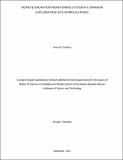| dc.contributor.author | Geofrey, Anna | |
| dc.date.accessioned | 2022-09-09T08:24:25Z | |
| dc.date.available | 2022-09-09T08:24:25Z | |
| dc.date.issued | 2021-09 | |
| dc.identifier.uri | https://doi.org/10.58694/20.500.12479/1576 | |
| dc.description | A project Report Submitted in Partial Fulfillment of the Requirements for the Degree of Master of Science in Embedded and Mobile Systems of the Nelson Mandela African Institution of Science and Technology | en_US |
| dc.description.abstract | Usage of radioactive materials in a number of countless activities has increased rapidly
worldwide, thus, increasing Uranium exploration in different countries including Tanzania. As
Uranium decays, it emits ionizing radiations, which has health risks associated with it. The major
threats occur when ionizing radiations produced during uranium decay exceed their levels.
Causing skin burns and acute radiation syndrome, though in the long-term cause cancer
and cardiovascular disease, are the substantial health effects to mention a few. Thus real-time
and remote monitoring of radiation at uranium mining sites is mandatory to ensure
environmental and human safety. Radiation detectors are used to monitor radiation at uranium
mining sites by frequently visiting however achieving real-time and remote monitoring is still
the challenge. This method is time-consuming and the existing radiation detectors used in
Tanzania are exported from developed countries and are expensive.
This design science study presents an effective and affordable system for remote monitoring of
radiation at uranium mining sites using internet of things (IoT) technology. The system used
prototype methodology and the radiation detector was programmed by using ESP32
microcontroller board. Which through its inbuilt Wi-Fi it was able to send data to the cloud data
storage. The Message Queuing Telemetry Transport protocol facilitated remote visualization of
radiation levels from the cloud storage dashboard and the developed mobile application. The
end-users monitored radiation data and received notifications in case of excess radiation through
the developed mobile application. The internet of things technology facilitated the end-users to
visualize and monitor radiation levels anytime and anywhere via the internet. | en_US |
| dc.language.iso | en | en_US |
| dc.publisher | NM-AIST | en_US |
| dc.subject | Research Subject Categories::TECHNOLOGY | en_US |
| dc.title | Remote radiation monitoring system at uranium exploration site in Mkuju river | en_US |
| dc.type | Thesis | en_US |

